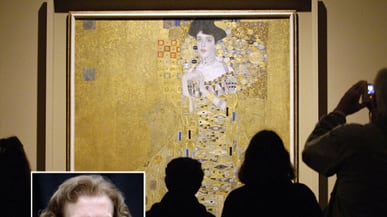With the death of Maria Altmann on Monday at age 94, the world has lost a trailblazer of Holocaust art restitution and one of the last links to painter Gustav Klimt’s Vienna. In recent years, Altmann won a monumental case to reclaim several Klimt portraits that had been stolen from her family by the Nazis. She was the niece of Adele Bloch-Bauer, the beautiful young aristocrat who became Klimt’s muse and the subject of his iconic gold portrait.

In 1998, when Altmann was 82 and living in Cheviot Hills, California, she began a seven-year battle to have the Portrait of Adele Bloch-Bauer I and several other pieces by Klimt restored to her family. After regaining the works, Altmann brought them back to the United States, and then swiftly sold the gold portrait to businessman Ronald Lauder, owner of the Neue Galerie, for a record-breaking $135 million.
I was lucky enough to spend time with this brave woman before she died. At the end of her life, she became a very private person, and, after the harrowing legal battle, stopped speaking to the press. In 2008, while I was researching my thesis on Portrait of Adele Bloch-Bauer, I wrote numerous letters to Altmann requesting an interview. They went ignored for months, until my phone rang one afternoon, and a distinctive Austrian accent came through the receiver. I immediately flew to Los Angeles to meet with her. We spent an afternoon in her sundrenched living room, eating cold cuts and cookies, as she shared stories of “Aunt Adele” and Gustav Klimt, her harrowing escape from Nazi-occupied Vienna, and the painful legal battle for her family’s rightful possessions.
When she posed for Klimt’s iconic portrait at the turn of the century, Bloch-Bauer was the grand dame of Vienna. The portrait depicts her against a gold-plated background, and is heavily influenced by the byzantine mosaics Klimt had seen in Ravenna. Speculation was rampant that the married muse once had an affair with the artist. The accusations weren’t believed by everyone. Altmann once told The New York Times: “My mother got mad and said, 'How dare you ask such a thing? It was an intellectual friendship…But I think it was very possible there was a romance.' " And as Altmann recalled of her aunt: “She slept with her dogs—not my uncle.”
To Altmann, her Aunt Adele was a serious woman, one who had no use for children or the chit-chat of petty women. She would float around the house, which was filled with chamber music, in flowing white gowns. “Adele was only involved in intelligent things,” she said. When Adele died tragically of meningitis at the age of 45—when Altmann was 9 years old—her widower, Ferdinand, set up a shrine in their home. Altmann described the scene: “The room was all Klimts and flowers.”
Adele left a will asking Ferdinand to leave the Klimts to the Austrian National Gallery. He held onto the paintings until 1938, when the Nazis entered Vienna and seized them. “I remember the Chancellor of Austria came on the radio and said the German troops are at the border, and we don’t want any blood shed, so we are not going to resist. God Bless Austria.” Altmann recalled. “And that was the end of an era.”
Altmann and her husband lived under close watch from Nazi officers until they escaped and caught a plane to Munich, climbed a barbed-wire fence into Holland, rented a private plane from Amsterdam to Liverpool, and obtained visas to enter New York. Eventually, they settled in California.
It took until 1998 for the restitution law in Austria to change and allow Altmann and the other heirs to fight for their family’s possessions. The family argued that Bloch-Bauer had only suggested that her husband leave the paintings to the museum—and that she could not have known what would befall Austria. “I call these paintings that were not returned, ‘the last prisoners of WWII,’” Ronald Lauder said.
The lawsuit against the Republic of Austria wound through the United States Supreme Court and an Austrian arbitration panel. “They delay, delay, delay, hoping I will die,” Altmann said in 2001. But as her lawyer, Randy Schoenberg, told me in 2008: “It was important to me to finish the case while Maria was still alive.”
In 2006, the panel ruled in favor of Altmann and the other heirs. It was a major moment for the art world—and a symbol of progress for art restitution. Altmann and her family brought the paintings to the U.S. immediately, putting them on temporary view at the Los Angeles County Museum of Art.
Altmann insisted that her pursuit of the paintings was fueled by a desire not only to be compensated for the Nazi looting, but also to return the Bloch-Bauer collection to the public on her own terms. Although the sale took Adele out of her homeland, most Austrians recognized its change of hands as a public restitution. Altmann recalled traveling to Austria shortly after the lawsuit: “I thought people were going to say, ‘It’s disgusting what you are doing,’ but out in the streets, people said: ‘Are you Mrs. Altmann? We are so happy that justice prevailed and you got the pictures back.' ”
In June 2006, in a private sale mediated by Christie’s, Lauder purchased Adele Bloch-Bauer I from Altmann and the other heirs for approximately $135 million, the most that had ever been paid for a painting at the time. He reminisced that he had first seen the painting in Vienna when he was 14 years old. “I always coveted the picture,” he said. “But it was in a museum. I never knew it would be available.” When the opportunity came to buy it, Lauder jumped. “I knew this was the only time I’d ever have to buy this painting,” he said. Since then, the painting has become the centerpiece of Lauder’s small museum, the Neue Galerie, in New York City. The four other paintings recouped by the family were sold for a total of $192.7 million and entered private collections.
“This is the great painting in Vienna at the turn of the century,” Lauder said at the time. “This is our Mona Lisa.” And while Altmann’s own face was never similarly immortalized, I remember sitting with her on that warm afternoon. She reminds me of her aunt in the portrait she fought for so fearlessly: stoic yet approachable, with a hint of a smile.
Plus: Check out Art Beast, for galleries, interviews with artists, and photos from the hottest parties.
Isabel Wilkinson is an assistant editor at The Daily Beast.






